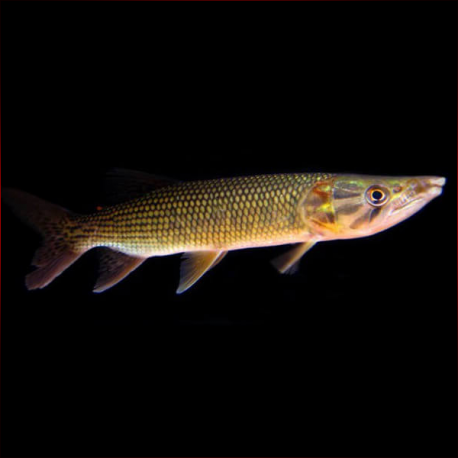More info
Datasheet
| Minimum Tank Size | 680 litres / 179.64 US gallons |
| Maximum Size | 70.0cm / 27.56inches |
| Temperature | 25°C / 77.00°F - 28°C / 82.40°F |
| Hardness | 8-18ºdH |
| pH | 6.0-7.5 |
General Description: The African Pike Characin, known scientifically as Hepsetus Odoe, is the sole species in its genus. Resembling the European Pike, this predatory fish boasts a striking appearance and a set of formidable teeth. Handling this species requires caution due to its ambush predator nature.
Aquarium Setup: To house the African Pike Characin, a minimum tank size of 680 liters is necessary. Juvenile specimens should be provided with ample hiding spots like driftwood, smooth rocks, and dense planting. Floating plants are recommended, alongside robust biological and mechanical filtration to manage the fish's waste. Due to their propensity for jumping, a secure cover for the tank is essential. Refer to the provided water conditions for maintaining ideal parameters.
Behaviour: African Pike Characins typically coexist peacefully with larger non-prey fish but should not be housed with aggressive species such as territorial cichlids. They can thrive in groups of similar-sized individuals; however, mixing sizes can lead to harassment and potential fatality for smaller fish.
Feeding and Diet: While being natural piscivores, African Pike Characins can adapt to consuming dead foods in captivity. Offer a varied diet of prawns, earthworms, mussels, lancefish, and more. Smaller individuals may require initial feeding of bloodworms or small earthworms. Some individuals might exhibit reluctance or refusal towards dead foods, needing patience and experimentation to find suitable alternatives.
Reproduction & Dimorphism: Reproduction of the African Pike Characin has not been documented in aquarium settings but may be possible in very large tanks. In their natural habitat, they are bubblenesters, with pairs becoming territorial and constructing large bubblenests among surface vegetation. The fry hatch and attach themselves to the nest under parental care before dispersing. Sexual dimorphism in this species remains unknown.
Habitat and Distribution: Found across various habitats like coastal lagoons, rivers, lakes, and swamps in Africa, H. odoe avoids areas with the predatory Tigerfish species, Hydrocynus forskahlii. Its distribution encompasses countries like Ghana, Nigeria, Angola, Guinea, and Botswana, among others, showcasing the species' wide range across the continent.

